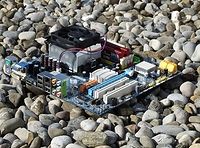DIY Solar-Powered PC: Solar Components
A Positional Tracking Solar Array
Our solar panels orient themselves automatically to the sun's position, and provide power for our solar-powered PC. A battery stores excess (or unused) power to provide juice for nighttime operation. In this third installment of our article series on a DIY solar powered PC, we explore and explain the construction of our solar array, describe necessary components and tools, work out the battery capacity and lifetime, and provide plenty of pictures of our experiment in installing and using solar power to drive our PC.
The total costs for our solar power delivery and storage system run in the neighborhood of $5,000.
Those readers who might like to start at the beginning of this series will find the first two installments here:
- Do-It-Yourself Solar-Powered PC: Technical Foundations
- Do-It-Yourself Solar-Powered PC: Hardware
- Do-It-Yourself Solar-Powered PC: Live Test
As you dig more deeply into solar power technology, you'll quickly come to understand that solar power for PCs or other electrical components are not readily available. That's why you shouldn't expect to pick up the gear (or even a suitable PC) at your neighborhood PC retailer. That said, we made sure to design and build our solar-powered PC as a normal desktop PC, even though it draws only 61 Watts, including the monitor.
Because nobody's done anything similar just yet, we can only assume this effort will spawn plenty of imitations. We were even able to achieve reasonable computing performance, thanks to the powerful yet energy-efficient dual-core AMD Athlon X2 BE-2350 we used in our system. Our extraordinarily low level of power consumption was only possible because we tested each and every candidate component carefully for efficiency: random selection of seemingly suitable components simply won't do. Our Munich test labs worried about every half-watt of power consumed, and designed this PC to run as long as possible, even when the sun isn't shining bright (or anywhere in sight).
In this third installment of our "DIY Solar Powered PC" series, we construct our solar array and position it on the roof of our Munich test lab. We'll show you which components we used and how to install each of them, step by step. Our most important observation in this regard is that the solar cells are constructed to orient themselves automatically to gather the sun's rays most efficiently. That's why we constructed the array so that manual adjustments aren't even necessary. That's also why we will briefly present all facets of the solar array's design and construction in a live Webcast very soon.
The solar-powered PC we described in Part 2 now runs entirely off solar power
Get Tom's Hardware's best news and in-depth reviews, straight to your inbox.
As we put this project together, we needed components that don't normally appear in standard solar power installations, to make it suitable to drive our PC. Because this entire project is something of a research project as well as a feasibility experiment, we chose not to use materials designed for permanent or long-standing use. This enabled us to be more flexible about the experiments we conducted, and to work "on the cheap." But the electrical circuits we used in our project are standard and well-documented, so that others can follow in our footsteps with relative ease.
Solar modules on the roof of our Munich test labs
Our solar array delivers up to 260 Watts of power at maximum output. With the current that our solar generator produces we power our PC all day long, and take advantage of our storage battery to deliver additional power at night, when the solar cells aren't producing any power themselves. As we started down this road, we had to work our way through numerous initial attempts, before we came up with an approach that produced the results documented here. Along with numerous size and arrangements of power leads, to connect our arrays to our battery and then to the PC, we also had to conduct complex calculations of our energy budget. One primary goal of our project has been and remains our desire to communicate our findings, and to stimulate further development of power generation techniques for the future.
Mounting and installing our rooftop solar arrays begins with framing them out.
On our Internet forums, we've observed that energy consumption for computers is one of the most popular topics of discussion. We have succeeded in building a desktop PC system that runs completely and exclusively off solar power, so that all typical office applications and uses may be carried out.
Current page: A Positional Tracking Solar Array
Next Page Polycrystalline Solar Cells Produce 260 Watts


